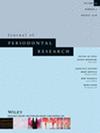Characterization of oral biomarkers during early healing at augmented dental implant sites
Abstract
Aim
The aim of this study is to assess early wound healing expression of local angiogenic biomarkers following connective tissue graft (CTG) at dental implant sites.
Methods
Twenty-eight subjects with single dental implants exhibiting a soft tissue dehiscence were included and randomly treated with CTG, either with coronally advanced flap (CAF) or with tunnel technique (TUN). Peri-implant crevicular fluid (PICF) was collected at the midfacial and midlingual aspect of the implant sites at baseline and at 3, 7, 14, 30, and 90 days after the surgical intervention. The expression of angiogenin (ANG), fibroblast growth factor-2 (FGF-2), platelet-derived growth factor (PDGF), tissue inhibitor of metalloproteinases-2 (TIMP-2), and vascular endothelial growth factor (VEGF) was investigated over a period of 3 months. Patient-reported outcomes, clinical measurements, and ultrasonography scans at multiple time points were also evaluated.
Results
The longitudinal regression revealed a significant difference in the expression of VEGF and TIMP-2 between CAF- and TUN-treated sites over 3 months (p = .033 and p = .004, respectively), whereas no significant differences were observed for ANG, FGF-2 and PDGF between the two groups. At 7 days, a direct correlation was observed between ANG levels and ultrasonographic color velocity in the CAF group (p < .001) and between ANG levels and ultrasonographic color power in the TUN group (p = .028). VEGF levels and ultrasonographic mean perfused area of the CTG were significantly correlated at the 7-day time point (p < .001 for both CAF and TUN). The expression of VEGF at 7 days was directly associated with mucosal thickness gain at 1 year (p < .001 for both groups). Early TIMP-2 expression showed an inverse correlation with time to recovery (p = .002). TIMP-2 levels at 3 months exhibited inverse correlations with mean dehiscence coverage (p = .004) and the rate of complete dehiscence coverage (p = .012).
Conclusion
PICF biomarkers can be used to monitor early wound healing events following soft tissue grafting at implant sites. VEGF and TIMP-2 showed correlations with the 1-year clinical and volumetric outcomes, as well as with post-operative patient-reported outcomes and Doppler Ultrasonographic tissue perfusion-related parameters.


 求助内容:
求助内容: 应助结果提醒方式:
应助结果提醒方式:


